Women's Career Development Survey
Actionable Insights
An inside look at the background and purpose.
The progress made by women in the workplace over the past decade is threatened by the pandemic and ensuing conditions. By focusing our research on women in Northeast Wisconsin, the data will offer actionable insights on the current careers of area women. This data will inform the work of the Schreiber Institute for Women's Leadership, enabling us to:
- Provide a regional look at women in the workplace
- Gauge current experiences and workplace supports
- Help women become more resilient
- Identify ways for workplaces to be positive supports for women
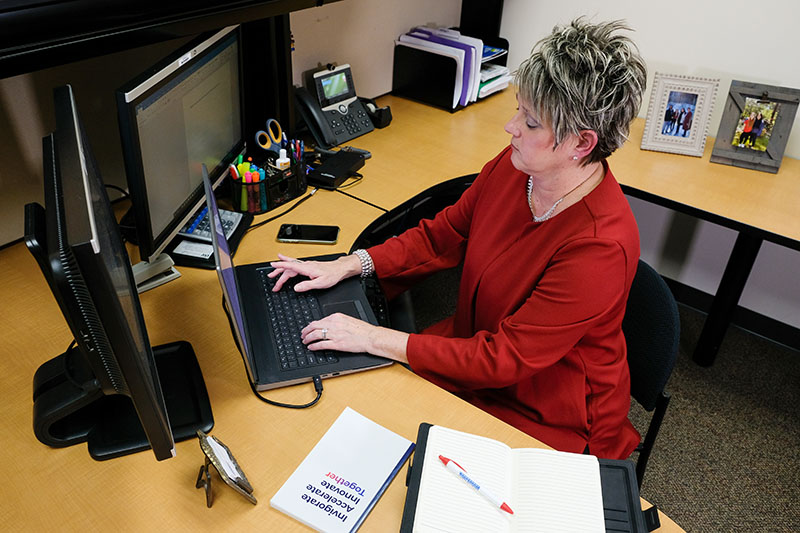
Survey Participation
Our goal was to reflect a wide swath of working women in many fields. In July of 2021 we shared the survey link throughout Northeast Wisconsin by email, social media, websites and press releases.

Distributed in the Region
Distribution partners included the NEW North board of directors and their partners, O’Connor Connective, Insight Magazine, Women’s Fund of Northeast Wisconsin, Management Women and other women’s groups.
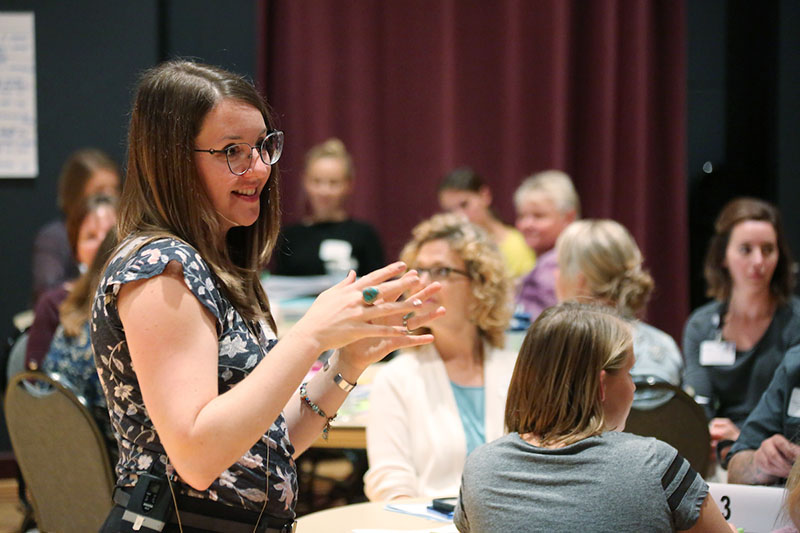
823 Women Participated
Of these, 7% were non-white, 6% owned their own business, 30% held senior management or higher positions, 45% had children at home and 20% are "working daughters."
Where does our career woman work?
Let's start by understanding what her work situation looks like.
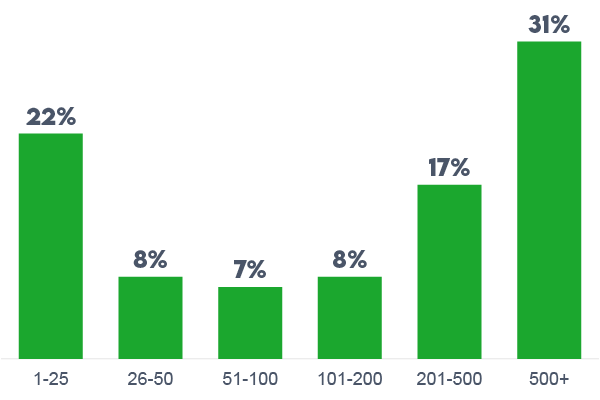
Size of Organization Where Employed
The women surveyed represent very large organizations, with almost half working in businesses with over 250 employees (n=759).
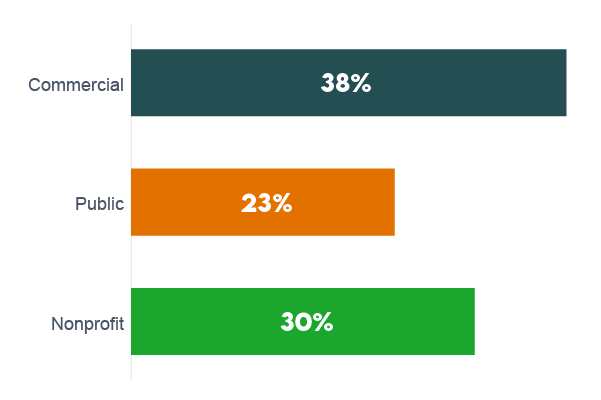
Business Sectors
30% of women work in the nonprofit sector, 23% in the public sector and the largest percent 38% work in the commercial sector (n=759).
She Works a Lot
Our survey represents women at every level of their career ― from entry level to C-Suite. 62% of women worked 41 hours a week or more. 15% planned to continue remote work.
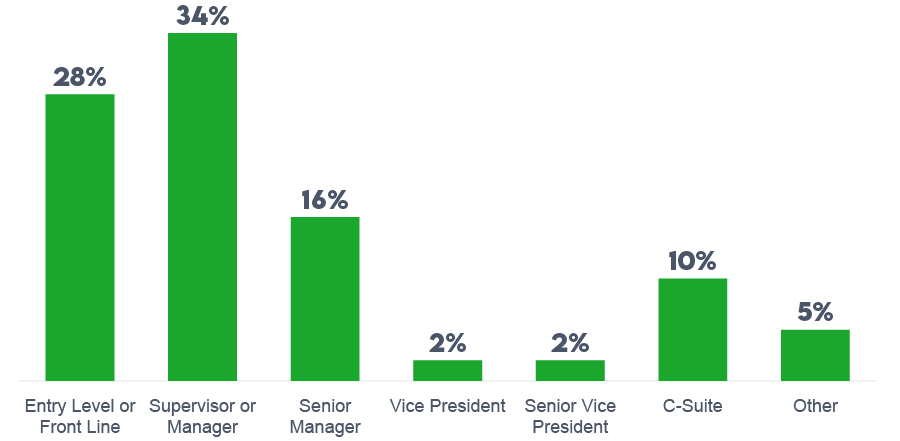
Current Position
A majority of women are supervisors or managers at 34%. 28% work in front line positions. 19% work as a vice president or higher position (n=797).
She is Experiencing Negative Situations
Many women experienced direct challenges in the workplace. 23% reported verbal harassment, 11% sexual harassment and 36% gender discrimination.
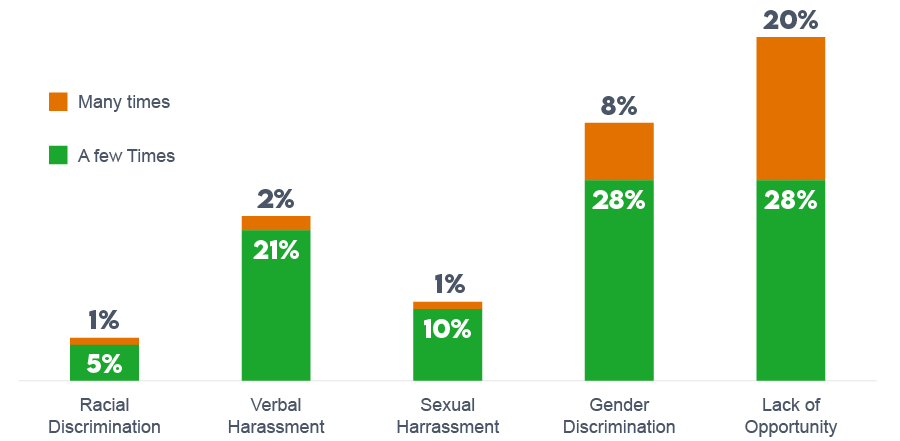
Reported Negative Experiences at Work
Almost half of women reported a lack of opportunity for advancement and growth – a major reason for low job satisfaction (n=823).
She Has Obligations
Let's not forget the home situation, which is slowly evolving. 20% of women are responsible for care of an adult dependent.
Person Responsible for Caring for Children & Homeschooling
50% of women are responsible for all or most of the childcare and homeschooling (n=324).
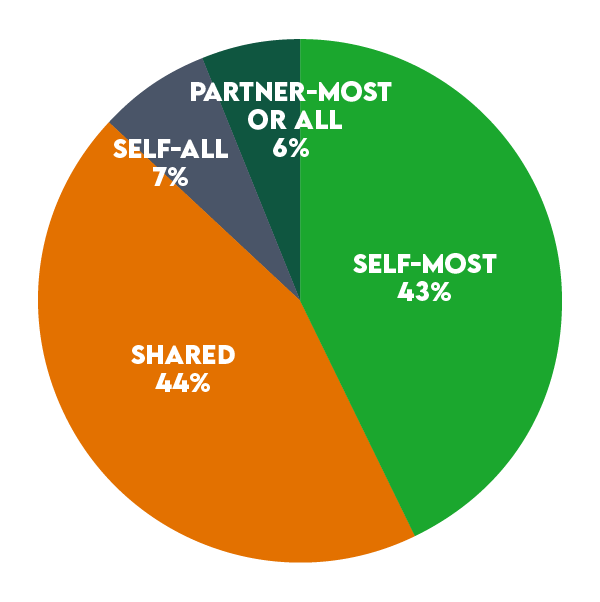
The Cost of Challenges at Work & at Home
- Almost half of women reported that feeling burned out was a "definite" challenge at work
- 38% reported feeling overwhelmed
- 31% had challenges with their own mental health
- "Working daughters" ― women who care for an adult dependent ― are at the greatest risk of downshifting careers
- Three-fourths of women do not plan to “downshift their careers” ― that is, reduce their hours or leave the workplace soon
- 8% of respondents seriously consider doing so and another 18% somewhat consider it
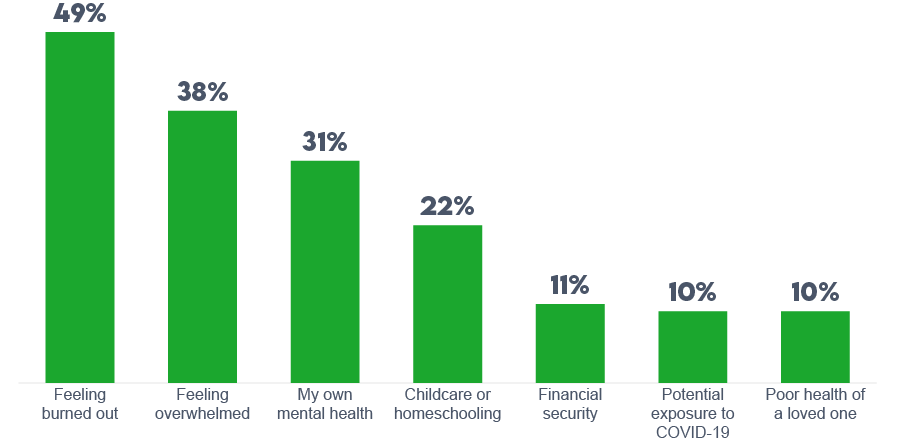
Most Significant Challenges Facing Women as Employees
Many women expressed challenges in the workplace, ranging from "feeling burned out" to "potential exposure to COVID-19" (n=823).
Her Workplace Culture Leaves Room for Improvement
- Less than half of surveyed women agreed they had career advancement opportunities
- 65% of women say that their workplace promotes a "work first" mentality
- 34% of women say their workplace is doing what it takes to support female employees
- 17% had employers that offered resources to help care for children
- Only 10% of women made use of mental health services
- Approximately 60% of women agreed they had managers who advocate for them, have mentors and feel optimistic about career potential
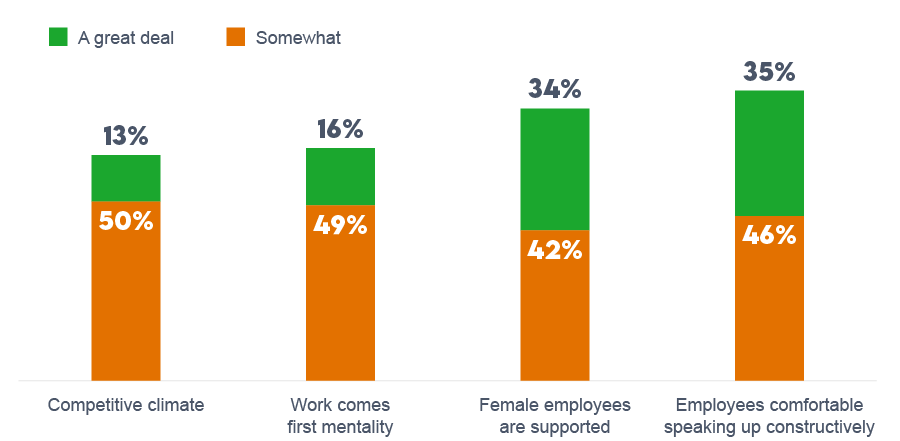
Women's Sense of Workplace Culture
Women gave their views on workplace culture, including attitudes or behaviors that can support or undermine employee performance (n=749-768).
Encouraging Employers to Look at Benefits in a New Way
There is a significant gap between benefits offered by employers and benefits women utilize. Greater alignment is needed between the needs women express and the benefits offered to help them. This is especially true as it relates to mental health and counseling services. While 58% of companies provide such counseling services, only 10% of women utilize them.
Key Takeaways
How the Institute can make this data actionable.
The single most important takeaway of the survey is that women employees are under pressure at home and at work. The objective of the Schreiber Institute for Women's Leadership is to assist women and their organizations to address and adapt to women's needs. This includes avoiding burnout and degradation of the female workforce, so to impact the economic vitality of the local region. Despite the disruptions of our current economy, there are actions the Institute can take, in partnership with organizations and their women leaders, to enhance women's job satisfaction and support for career development. The following outlines key steps we commit to immediately and invite you to join us.
The top three challenges reported by women concern mental health.
Action Item for the Institute: Conduct workshops and panels on how to manage burnout and stress in the workplace.
There is a lot of interest in downshifting.
Action Item for the Institute: Host guest speakers who have successfully downshifted for discussions about how they accomplished this transition. Additionally, consider workshops that discuss alternatives to downshifting, including how to advocate for work flexibility, better work-life balance and monthly allocated work-time hours to engage in informal leadership initiatives and networking.
Supportive workplace cultures help with development of leaders.
Action Item for the Institute: Highlight and publicize workplaces that have positive conditions and benefits to support women. Offer workshops on development of positive workplace cultures that avoid harassment and discrimination.
Women face a variety of challenges.
Action item for the Institute: Share information widely about the challenges faced by women professionals in this region to heighten awareness. Serve as Institute ambassadors to help other women know of the resources available through the Institute.
Women need new or different kinds of benefits.
Action item for the Institute: Share information widely about innovative benefits being offered in workplaces that support women professionals in ways that they need. Organizations can increase awareness of what to offer talented professionals to attract and retain them.
Advocates and mentors are needed.
Action item for the Institute: Provide and participate in workshops to help managers learn ways to advocate and support women employees.
Women are looking for more opportunities for growth.
Action item for the Institute: Offer trainings and programs to help women learn strategies to develop their own career paths, and coach managers in ways to help employees grow to their full potential. Learn more about professional pathways offered by the Institute.
About the Study
This inaugural survey of working women in Northeastern Wisconsin was conducted by UW-Green Bay's Center for Public Affairs on behalf of the Schreiber Institute for Women's Leadership. Access the complete report on the Center's webpage.

Just Ask!
Have questions about our survey report? Often data leads to more questions. We’re happy to clarify. Your understanding can shape your leadership journey.